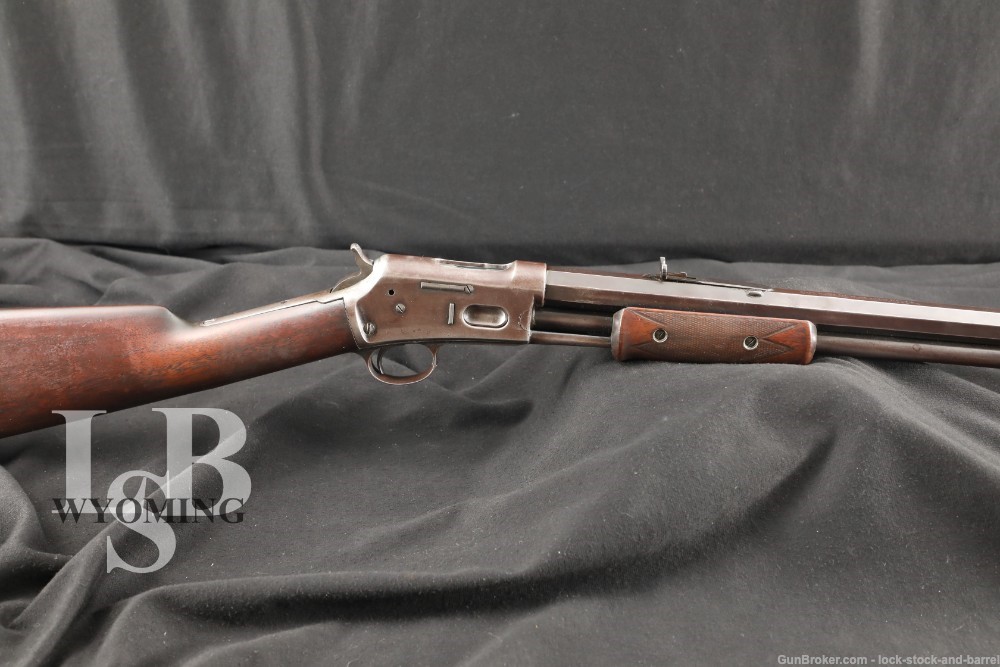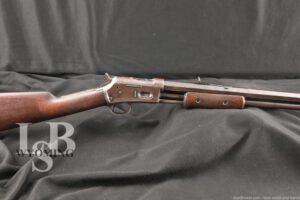
Early Colt Lightning Magazine Rifle Medium Frame Carbine CLMR, 1886 Antique
SOLD FOR: $1,030.00
WOA#: WY240602BT012
Make: Colt
Model: Lightning Magazine Rifle, Medium Frame Carbine
Serial Number: 15774
Year of Manufacture: 1886
Caliber: .38 CLMR (.38-40 Winchester)
Action Type: Slide / Pump Action, Full Length Tube Magazine Fed Rifle
Barrel Length: 26”, Octagon
Sights / Optics: The front sight is a blade integral to a rectangular base, fixed to the front of the barrel behind the front barrel band. The rear sight is dovetailed to the rear of the barrel. The sight presents a “V”-notch and is adjustable with an escalator.
Stock Configuration & Condition: The stocks are walnut with a two-piece checkered slide handle, straight grip, straight comb and steel carbine buttplate. The stocks have some scattered nicks, dings, scuffs and scratches. The checkering has smoothed at the peaks. There are patches of finish that have glazed on the stock. Most likely from being hung over the fireplace. The LOP measures 13 1/4? from the front of the trigger to the back of the buttplate. The plate has gone to a moderate-dark patina from the heel over the face to the toe. Overall, the stocks are in Good condition as antique.
Type of Finish: Blued
Finish Originality: Original
Bore Condition: The bore is dull with well defined rifling. There is some scattered light erosion and pitting. There are two “eggs” or bulges in the barrel in the bore. In this writer’s opinion, the bore rates 3 /10.
Most antique firearms have bores that will show erosion. This is not only due to age but to the use of black powder. When fired, black powder reacts corrosively. NRA Antique Firearm Conditions Standards are quite lenient for bores. In some cases the NRA standards disregarded the bore’s condition for collectors firearms.
Overall Condition: This rifle retains about 55% of its metal finish. Strongest finish is in the magazine tube. Other surfaces have scattered finish, mottled with areas which have gone to a light patina and scattered light surface oxidation. Most edges are worn to white. There are scattered nicks, scuffs and scratches. The top tang has a notable scratch to the left of the large tang screw. There is a bubble in the barrel 7 inches from the receiver. Inside the barrel there are signs of a squib loaded once or twice that was attempted to be shot out. The screw heads range from sharp to tool marked with strong slots. The markings are clear with good detail in the rampant colt. Someone has vigorously cleaned the left side of the receiver to see the horse better. I feel the job could have been executed in a different manner. Overall, this rifle is in fair condition as Antique.
Mechanics: The action functions correctly but is quite loose due to its age. This rifle had a bolt-lock switch in the front of the trigger guard, this piece is missing, and was typical of early production rifles. We have not fired this rifle. As with all previously owned firearms, a thorough cleaning may be necessary to meet your maintenance standards.
Box, Paperwork & Accessories: None
Our Assessment: Around the 1880s, Colt was looking to diversify but both Remington and Winchester had the rifle market sewn up. Besides their lever-actions, there were also new slide action rifles: the user pumped a moving arm set under the barrel and around a tubular magazine, kicking out a spent round and loading a new one with every “stroke”. Colt concentrated on this design concept and in 1884 introduced a gun with a short slide action that was so slick and so fast; they dubbed it the “Lightning”. The advertising said it all: “Nothing was faster than lightning”. Dr. William H. Elliot, a dentist by trade, designed the gun. Half hobby, half side job, Elliot liked to tinker with things and over the course of his life came up with at least 130 inventions. Since he lived in Ilion, New York, he often walked down to neighboring Remington and showed them the interesting things he was working on and when Remington didn’t bite on his new rifle design, he sent a letter to Colt, who loved it.
The handy rifle’s tubular magazine could hold as many as 16 rounds, depending on caliber, which made it very attractive. It came in three varieties: small, medium, and large. Each of these guns had the same set up, with a deep-blued finish, case hardened hammer, American walnut stock and fore-end, and open rear and front sights. They were light, going 6.5-pounds or so. The medium frame guns, chambered for .32-20, .38-40 and .44-40 Winchester calibers, marketed as 32, 38 and 40 CLMR (Colt Lightning Magazine Rifle), were the most popular, using some of the same cartridges as Colt’s Single Action Army and with ammunition already being produced for Winchester’s rifles. Ultimately, the rifle was discontinued as Winchester and Colt came to the agreement that Winchester would produce rifles, Colt would produce handguns, and nobody needed to make the market competition get ugly.
This example is a fairly early production medium frame made in 1886 and chambered for .38-40. It is a desirable Carbine model with a 26? octagon barrel, sights and buttplate. The rifle has some neat early features including the “ELLIOT’S PATENT” barrel address as well as a spot for the slide-lock-switch in the trigger guard which would be later discontinued. Despite coming up on 140 years old, the rifle still retains about 55% of its original blued finish., it also still retains a nice, detailed rampant colt marking on the left of the receiver, a light marking which is frequently seen incomplete and even completely worn away. While this rifle would likely have seen exclusive use with black powder, it still retains rifling bore. This will make for a nice example of the Colt Lightning Carbine and would be an excellent addition to any safe in America. So bid high and bid firm. I highly encourage you to take a look at the condition in our high quality photos. Good luck on your bid. -K.F.

